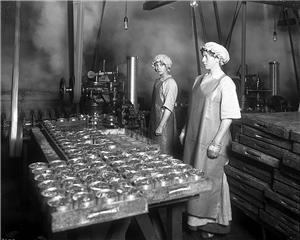On October 14, 1891, the schooner Lizzie Colby lands the first load of Bering Sea cod at the Anacortes wharf of J. W. Matheson's newly constructed cod fish curing plant. This ushers in a new industry for the Skagit County city, in which fish will not only be caught but also processed or canned. Fish processing in Anacortes begins with cod and diversifies, with salmon canning growing into the largest production. By 1922, twelve canneries and curing plants will stand along Guemes Channel, bringing in millions of dollars of profits and wages to the city. The industry will face dramatic changes, but three large Anacortes seafood plants will continue the tradition in the twenty-first century.
Captain Matheson Arrives
J. W. Matheson, who hailed from Massachusetts, arrived on Puget Sound eager to find a base for his schooner Lizzie Colby, which would soon be employed in the cod fisheries off the coast of Alaska. At this point San Francisco, whose ships made yearly trips up to the rich northern waters, was the only cod fishing center on the West Coast of the United States. Matheson anticipated that a base on the Sound would have a competitive advantage over the San Francisco fishermen. He chose Anacortes and quickly ingratiated himself with the townspeople by praising the town's potential and mocking the Seattle interests whose paper had assumed that he would base his operations there.
Matheson hoped not only to catch but also to package cod and ship it from Anacortes. For this purpose he constructed a curing plant that was ready for operation when the
Lizzie Colby
arrived with forty-five tons of fish on October 14, 1891. The ship was late in arriving as she had sailed all the way around South America and dropped a load of coal in San Francisco before heading to the Bering Sea. The
Anacortes American
noted that the fish were unloaded, washed, and "placed in pickle" in two days and would be left to cure for two to three weeks before being removed to dry in the sun. One wonders how long the drying process took under the heavy November skies. Next, the fish would be boxed and shipped, or deboned for the local market.
In the coming years, not only the captains but many of the crewmen for the cod boats hailed from the East Coast. Having trouble keeping local men on the ships for the duration of the voyage, Captain Matheson soon employed dozens of professional fishermen from Gloucester who brought their expertise to the Pacific. On March 29, 1906, the Anacortes American reported that the schooner Alice embarked "twenty Dories and 36…jolly men, the larger part consisting of the high line fishermen of Gloucester, Massachusetts."
The industry expanded rapidly and attracted new entrepreneurs. In 1904 another Gloucester captain had settled in Anacortes, built a modern, three-story, fully-equipped cod-curing plant, and added two new schooners to the Anacortes fleet. On September 17, 1914, the Anacortes American proudly noted the return of the city's four codfishing ships with a record 793,000 cod. The Fannie Dutard, the last to arrive, unloaded 170,000 fish weighing 370 tons.
Although fish-processing began with cod in 1891, salmon canning soon far-exceeded even the growing cod industry in Anacortes. The first salmon cannery, built by the Alaska Canning Company on Ship Harbor west of downtown, near the present-day site of the Washington State Ferry terminal, began operation in 1894. In 1896 a clam cannery opened, but the facility soon switched to salmon. The industry continued to grow until eleven canneries lined the wharfs by 1915, along with other curing plants.
Employing a diverse work force, including many Japanese, the canneries created controversy over wages and race. Some whites resented that Japanese employees would work for lower wages and cannery operators replied that the industry required lower wages or no wages. Distrust of the mostly male Japanese workers persisted and open racism limited what parts of fish could be handled by Asian workers. At times a plant would lay off minority employees.
Despite racial tension in the town, the industry continued to prosper as the world retained its appreciation of seafood. A truly global market meant that canned salmon could be -- and was -- shipped around the world and far from the ocean. Fresh fish and seafood also were shipped around the Sound to local markets and by 1910 Anacortes fishermen were the principal suppliers of crab and shrimp to Seattle residents.
Today, Seabear Smokehouse (opened in 1977), Sugiyo USA (1987), and Trident Seafoods (1989) continue the legacy of fish processing in Anacortes.

